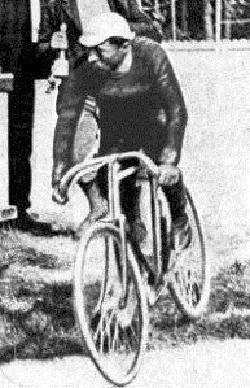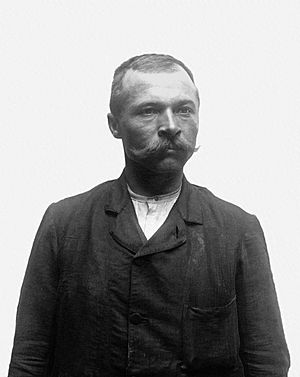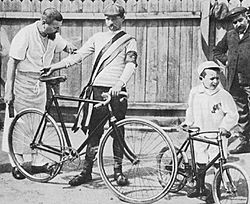Maurice Garin facts for kids

Garin in 1897
|
|||
| Personal information | |||
|---|---|---|---|
| Full name | Maurice-François Garin | ||
| Nickname | Le petit ramoneur (The Little Chimney-sweep) |
||
| Born | 3 March 1871 Arvier, Aosta Valley, Italy |
||
| Died | 19 February 1957 (aged 85) Lens, France |
||
| Height | 1.62 m (5 ft 4 in) | ||
| Weight | 60 kg (132 lb) | ||
| Team information | |||
| Discipline | Road and track | ||
| Role | Rider | ||
| Rider type | Distance rider | ||
| Major wins | |||
|
|||
Maurice-François Garin (born March 3, 1871 – died February 19, 1957) was a famous bicycle racer. He was born in Italy but later became a French citizen. Maurice Garin is best known for winning the very first Tour de France race in 1903. He also won the second Tour in 1904, but his title was taken away due to cheating.
Contents
Early Life and Family

Maurice Garin was born in a small village called Arvier in the Aosta Valley, Italy. This area is close to the French border. His family had nine children, four girls and five boys. Maurice was the first son.
In 1885, when Maurice was about 14, his family moved to France. He started working as a chimney sweep. By age 15, he was living in Reims, France, still working as a chimney sweep. He later moved to Charleroi in Belgium, but by 1889, he was back in France, living in Maubeuge.
Maurice's brothers, François and César, also stayed in northern France. In 1895, they opened a bicycle shop in Roubaix with Maurice. Two of his brothers, César and Ambroise, also became professional cyclists.
In 1902, Maurice Garin moved to Lens, Pas-de-Calais, where he lived for the rest of his life. He bought his first bicycle in 1889. It cost 405 francs, which was a lot of money back then. He loved riding his bike so fast that people called him le fou, meaning "the madman."
Amateur Racing Days
Maurice Garin started racing bicycles in northern France in 1892. The secretary of the cycling club in Maubeuge convinced him to join a local race. It was a long race, about 200 kilometers. Maurice finished fifth, even though he struggled in the sun. This experience made him want to race more.
His first victory came in 1893 in a race in Belgium. He had bought a lighter bicycle for this race. During the race, he got a flat tire. He quickly grabbed a spare bike meant for a rival and rode off to win the race! He finished ten minutes ahead of everyone else.
Becoming a Professional Cyclist
Maurice Garin became a professional cyclist by accident. He wanted to join a race, but when he arrived, he found out it was only for professionals. He wasn't allowed to compete. So, he waited for the racers to start, then rode after them and passed them all! He even fell twice but still finished ahead of the professionals. The crowd cheered for him, and people collected money to give him a prize. This made him decide to become a professional.
His first big professional win was a 24-hour race in Paris in 1893. This race was held near the Eiffel Tower. It was very cold, and many riders quit. Maurice Garin rode 701 kilometers in 24 hours! He beat the only other rider who finished by 49 kilometers. While other riders drank a lot of wine, Garin had a very unusual diet during the race. He drank hot chocolate and tea, ate eggs, cutlets, rice, and even oysters!
In 1894, he won another 24-hour race in Belgium. The next year, he set a new record for how far a cyclist could ride in one hour behind pacers (other riders who help set the speed).
Maurice Garin also did very well in famous one-day races. In the first Paris–Roubaix race in 1896, he came in third place. He might have finished second, but he was knocked over by a crash. In 1897, he won Paris–Roubaix, and he won it again in 1898!
In 1901, he won the Paris–Brest–Paris race. This race was incredibly long, about 1,208 kilometers. He finished almost two hours ahead of the second-place rider. He even stopped for a bath during the race to recover!
Maurice Garin officially became a French citizen on December 21, 1901. In 1902, he won another major race called Bordeaux–Paris, which was 500 kilometers long.
Winning the Tour de France
The First Tour: 1903
The Tour de France was created to help promote a new sports newspaper. The race was planned to be very long, but not many people wanted to join. So, the organizers made it shorter and offered money to riders.
The first Tour de France began on July 1, 1903, near Paris. It was a huge circle around France, with six stages (parts) of racing. One stage was 471 kilometers long! Sixty riders started the race, but only 21 finished. Maurice Garin won the first Tour de France! He finished in 94 hours, 33 minutes, and 14 seconds. He won a lot of prize money for his victory.
The Second Tour: 1904
Maurice Garin also won the 1904 Tour de France. However, he was later stripped of his title. This means his win was taken away. The title was then given to another rider, Henri Cornet.
The 1904 race was very exciting for fans, but it also had many problems. Spectators sometimes tried to stop rival riders. Riders also cheated. Nine riders were kicked out of the race for things like riding in cars or being pulled by them. There were even stories of riders putting tacks on the road to cause flat tires. Some people said Maurice Garin himself broke rules, and there were even rumors he took a train during the race!
In December 1904, Maurice Garin and several other top finishers were disqualified. The details of exactly what happened were lost over time. Maurice Garin was banned from racing for two years.
Life After Racing
After his cycling career, Maurice Garin opened a garage in Lens, France. He ran this garage until he passed away. The garage is still there today, though it looks very different.
Maurice Garin always loved cycling. In 1949, he visited his birthplace in Italy to see the Tour de France pass through. After World War II, he even started his own professional cycling team.
Remembering Maurice Garin
Maurice Garin is remembered as a determined and strong man.
- In 1933, a cycling track in Lens was named the Stade Vélodrome Maurice Garin in his honor.
- In 2003, a street in Maubeuge was named after him to celebrate 100 years since his 1903 Tour de France win.
- In 2004, a special cobblestone, a traditional trophy for winners of the Paris–Roubaix race, was placed on his grave.
- In his hometown of Arvier, Italy, there is a monument dedicated to him. Many people visit his birthplace, like a special trip.
Career Achievements
Major Results
- 1893
- Dinant-Namur-Dinant
- Paris 80km (velodrome)
- 1894
- Liège 24hr (velodrome)
- Paris-Saint-Malo
- 1895
- 24hr Arts libéraux de Paris (velodrome)
- Guingamp-Morlaix-Guingamp
- World record 500km behind human pacer on the road 15h 2m 32s
- 1896
- Paris-Le Mans
- Paris-Mons
- Liège-Thuin
- 3rd Paris–Roubaix
- 1897
- Paris–Roubaix
- Paris-Royan
- Paris-Cabourg
- Tourcoing-Béthune-Tourcoing
- 1898
- Paris–Roubaix
- Tourcoing-Béthune-Tourcoing
- Valenciennes-Nouvion-Valenciennes
- Douai-Doullens-Douai
- 50km Ostend (velodrome)
- 2nd Bordeaux–Paris
- 1899
- 3rd Bordeaux–Paris
- 3rd Bol d'Or (velodrome)
- 1900
- 2nd Bordeaux–Paris
- 2nd d Bol d'Or
- 3rd Paris–Roubaix
- 1901
- Paris–Brest–Paris
- 1902
- Bordeaux–Paris
- 1903
- Tour de France
Grand Tour Results
| Grand Tour | 1903 | 1904 |
|---|---|---|
| Tour de France | 1 | DSQ |
| Giro d'Italia | N/A | N/A |
| Vuelta a España | N/A | N/A |
| 1 | Winner |
| 2–3 | Top three-finish |
| 4–10 | Top ten-finish |
| 11– | Other finish |
| DNE | Did Not Enter |
| DNF-x | Did Not Finish (retired on stage x) |
| DNS-x | Did Not Start (no started on stage x) |
| HD | Finished outside time limit (occurred on stage x) |
| DSQ | Disqualified |
| N/A | Race/classification not held |
| NR | Not Ranked in this classification |
Images for kids
See also
 In Spanish: Maurice Garin para niños
In Spanish: Maurice Garin para niños





